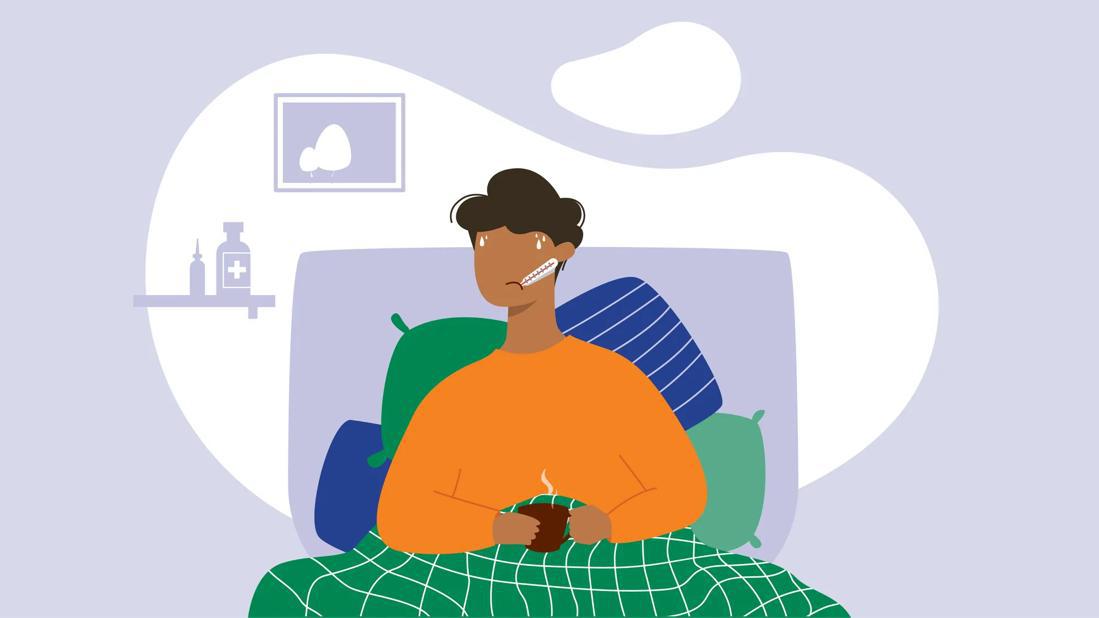What Happens When Your Body Has a Fever
When your body is fighting infection, your internal temperature rises as a defensive response

Most of us associate a fever with someone touching our forehead and saying: “You’re feeling a little warm.”
Medically speaking, a fever is measured by temperature: specifically, 100.4 degrees Fahrenheit (38 degrees Celsius) or higher. This happens not because of the infection or virus. Rather, because the virus or bacteria is seen as an attack, which triggers a response from your body’s immune system.
“We tend to think of a fever as something bad that we want to bring down — it’s very uncomfortable. But the funny thing is, it’s our own body starting to fight off what’s invading us,” explains family medicine specialist John Hanicak, MD.
Here, Dr. Hanicak breaks down exactly what happens to your body when you have a fever, and how to find relief.
What’s happening to my body when I have a fever?
When you have a fever, warming up is your body’s natural response to fighting a virus. Think of it like a fire alarm that goes off when there’s a sign of smoke. Normally, your body temperature is around 98.6 F (37 C). When it hits 100.4 F (38 C) or higher, it’s signaling that something is wrong.
“If a virus gets into our system, it’s in the mucus membranes and it starts to show up in the bloodstream,” says Dr. Hanicak. “Then, our immune system releases inflammatory chemicals that increase our core temperature.
“That higher temperature makes it very uncomfortable for the virus to live. Your body is literally trying to cook the virus out.”
Some other things that happen when you have a fever:
- An increase in metabolism.During a fever, your body uses more oxygen, increases your heart and respiratory rates, and uses more protein as an energy source.
- Your immune system goes into overdrive.Your immune system works better in higher temperatures, and your white blood cells become more active. This helps your cells respond quicker against the infection.
- Your muscles contract.This can cause you to shiver or feel chills (even if you’re sweating or feeling hot at the same time).
- Your blood vessels constrict. When you have a fever, your vessels narrow to elevate your body’s temperature and fight infection.
Low-grade vs. high-grade fever
There are different types of fevers that tell us the severity of the infection. If your temperature goes slightly above the normal range, it’s not always a cause for concern.
A low-grade fever is between 99 F and 100.9 F ( 37.2C to 38.3 C). “What we call a low-grade fever may actually represent a different set of illnesses than something that gives a high fever,” clarifies Dr. Hanicak.
You can get a low-grade fever with any virus, as well as other issues like an ear infection or strep throat. The symptoms of a low-grade fever are typically on the milder side, like slight fatigue, headache and/or chills.
On the other hand, a high fever is usually a sign of a more serious infection or inflammatory condition. A high-grade fever is 103 F (29.4 C) or higher. It can be seen with something like influenza (the flu), pneumonia or COVID-19.
With a high fever, you may feel symptoms like severe chills, confusion, rapid breathing and increased heart rate.
This is when you should seek medical attention if the temperature doesn’t go down within a day or two.
How to fight a fever
According to Dr. Hanicak, you don’t always have to get rid of a fever because it’s a natural part of our immune response. But that doesn’t make it any less uncomfortable to deal with. If the fever is making you very uncomfortable, then it is worth treating.
“At that point, the goal is to get more comfortable so you’re not losing as much fluid and can sleep and rest and, therefore, get better faster,” he adds.
Here’s what he recommends:
- Medications.“We do recommend that you take something like acetaminophen (Tylenol®) or anti-inflammatory medications (NSAIDS or nonsteroidal anti-inflammatory drugs) like ibuprofen (Advil® or Motrin®) or Alleve® (naproxen) to bring down the temperature because you can get dehydrated easily when your body is warm,” explains Dr. Hanicak.
- Consume lots of fluids. You’re sweating more and your immune system is running in high gear, which makes you lose fluids, so it’s important to drink more than usual. That’s why our caregivers bring us water, tea and chicken soup.
- Rest.Whether it’s a low or high fever, now is the time to take it easy. Remember, your body is hard at work fighting off an infection, so don’t make it do any more than it needs. Focus on getting bed rest and staying off your feet at least until the fever starts to drop.
- Cool down.If you’re feeling especially warm, try applying a cool, damp cloth to your forehead or the back of your head. Keep your clothes light and loose so your body has a lot of room to breathe.
When should I see a doctor for a fever?
How do you know when to go to the doctor? Dr. Hanicak says that if your temperature is below 100.4 F, you’re probably OK. But you should see a healthcare provider if you’re experiencing:
- A high-grade fever.If the fever is above 103 F (39.4 C) in adults or 100.4 F (38 C) in infants, you should see a provider.
- A persistent fever.Even if your fever isn’t technically rising, it’s still not a good sign if it’s not going down. If the fever lasts more than three days, it’s best to see a healthcare provider.
- Other symptoms.If your fever is paired with severe symptoms like a stiff neck, confusion, difficulty breathing, persistent vomiting, a rash or any concerning symptoms, it’s important to see a provider.